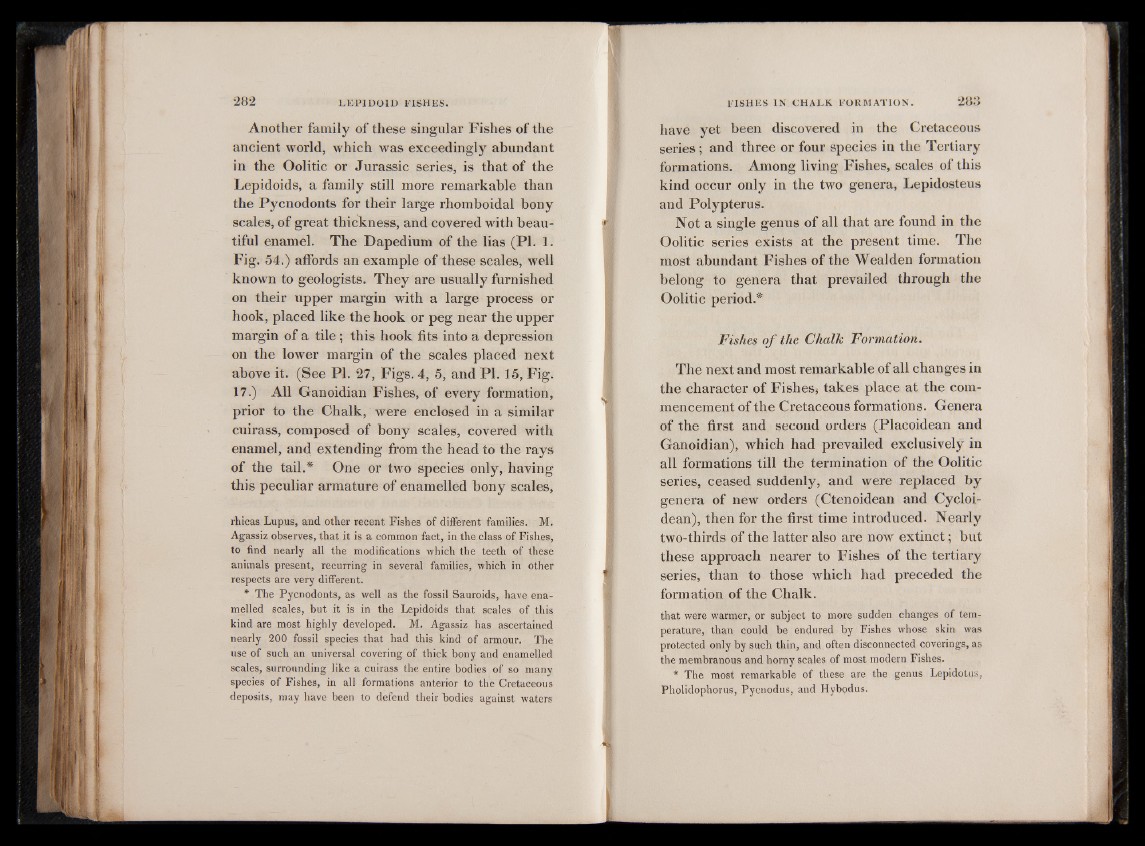
Another family of these singular Fishes of the
ancient world, which was exceedingly abundant
in the Oolitic or Jurassic series, is that of the
Lepidoids, a family still more remarkable than
the Pycnodonts for their large rhomboidal bony
scales, of great thickness, and covered with beautiful
enamel. The Dapedium of the lias (PI. 1.
Fig. 54.) affords an example of these scales, well
known to geologists. They are usually furnished
on their upper margin with a large process or
hook, placed like the hook or peg near the upper
margin of a tile; this hook fits into a depression
on the lower margin of the scales placed next
above it. (See PI. 27, Figs. 4, 5, and PI. 15, Fig.
17.) All Ganoidian Fishes, of every formation,
prior to the Chalk, were enclosed in a similar
cuirass, composed of bony scales, covered with
enamel, and extending from the head to the rays
of the tail.* One or two species only, having
this peculiar armature of enamelled bony scales,
rhicas Lupus, and other recent Fishes of different families. M.
Agassiz observes, that it is a common fact, in the class of Fishes,
to find nearly all the modifications which the teeth of these
animals present, recurring in several families, which in other
respects are very different.
* The Pycnodonts, as well as the fossil Sauroids, have enamelled
scales, but it is in the Lepidoids that scales of this
kind are most highly developed. M. Agassiz has ascertained
nearly 200 fossil species that had this kind of armour. The
use of such an universal covering of thick bony and enamelled
scales, surrounding like a cuirass the entire bodies of so many
species of Fishes, in all formations anterior to the Cretaceous
deposits, may have been to defend their bodies against waters
have yet been discovered in the Cretaceous
series ; and three or four species in the Tertiary
formations. Among living Fishes, scales of this
kind occur only in the two genera, Lepidosteus
and Polypterus.
Not a single genus of all that are found in the
Oolitic series exists at the present time. The
most abundant Fishes of the Wealden formation
belong to genera that prevailed through the
Oolitic period.*
Fishes o f the Chalk Formation.
The next and most remarkable of all changes in
the character of Fishes* takes place at the commencement
of the Cretaceous formations. Genera
of the first and second orders (Placoidean and
Ganoidian), which had prevailed exclusively in
all formations till the termination of the Oolitic
series, ceased suddenly, and were replaced by
genera of new orders (Ctenoidean and Cycloi-
dean), then for the first time introduced. Nearly
two-thirds of the latter also are now extinct ; but
these approach nearer to Fishes of the tertiary
series, than to those which had preceded the
formation of the Chalk.
that were warmer, or subject to more sudden changes of temperature,
than could be endured by Fishes whose skin was
protected only by such thin, and often disconnected coverings, as
the membranous and horny scales of most modern Fishes.
* The most remarkable of these are the genus Lepidotus,
Pholidophorus, Pycnodus, and Hybodus.